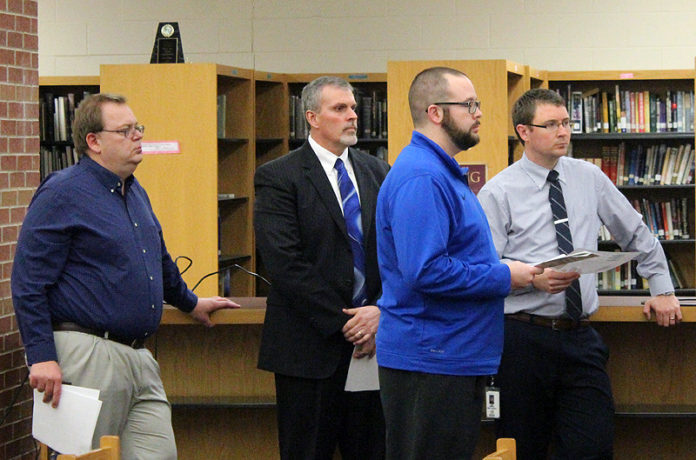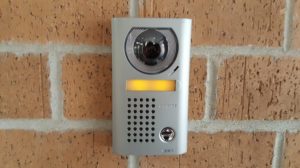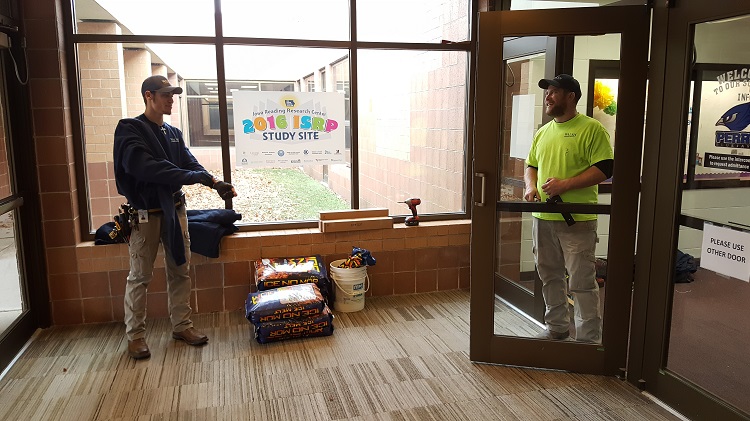
Topics ranging from school security to district report cards combined with the presentation of several reports to keep the Feb. 13 meeting of the Perry Community School District Board of Education moving at a brisk pace.
First to address the board were Nate Hugeback from Walsh Electronic Security and Rich Nichols, Perry technology director. The pair informed the board on the functioning of keyless entry points and the more than 80 new security cameras installed in the three school buildings.
One of the new functions happens when a card is swiped for entry, as a camera dedicated to that entrance will record the person entering — or trying to gain entrance — at that door. Another advantage is an “open door alert” that informs administrators when a door has been propped open, with the camera covering that door showing what is happening.
Building principals spoke to the board about the recent report cards given to the district.
Elementary Co-Principal Joel Martin said while some areas had seen a drop, he was convinced “we are reaching, and are making progress with” the students most in need of additional help.

Co-Principal Ned Menke said he was proud of the progress the staff at the elementary school was making.
“The thing I would like to see us focus on is that the trend is upward, that while it may be slow but steady, we are making progress,” Menke said. “You can look at these numbers (on the report card) in different ways, but are we moving in the right direction? The answer to that is ‘Yes, we are.'”
Middle School Principal Shaun Kruger said it was dangerous to compare districts by just looking at raw numbers.
“For example,” he said, “if we have 40 English-proficient students move out and 40 who are not proficient move in, and 20 pass their tests, then our overall number is going to go down when in fact we would be pleased with those results.”
Kruger said staff retention was one example of the school continuing to improve despite increased numbers of students receiving free or reduced lunches, which often produce demographic challenges other schools do not face.
Senior High Principal Dan Marburger touched on many of the same areas in his report.

“We do better than average with middle-class Caucasian kids who read English well. Our challenge is with all the other kids,” he said. “Those kids make up a significant percentage of our numbers, and that creates challenges other districts don’t have to face. If you want to compare us to someone, compare us to a district that looks like ours.”
“There is always room for improvement,” Marburger said, “but our staff has done a great job of recognizing where those needs are and in addressing them. We get better every year, and I am proud of the job our staff is doing.”
Board President Kyle Baxter was quick both to support the principals and call into question the value of the district report cards in the first place.
“You could take a quick look at these numbers and get the wrong impression, which is damaging to the community,” he said. “I keep seeing things improving, that everything is always getting better. I think most of this is a waste of our time and a waste of state funds.”
Superintendent Lynn Ubben and Director Linda Andorf informed the board of their recent visit to the state capitol for the Iowa Association of School Board’s Day On the Hill.

Ubben discussed the recent approval of 1.1 percent in school funding, which the IASB had hoped would be 4 percent and which Governor Terry Branstad had pushed at 2 percent.
She added the issue of parental choice had come up in discussion with legislators and that some changes may be coming regarding home schooled students.
“I know some very educated people who home school their kids and do quite well at it,” Ubben said. “It used to be they had to meet with a certified teacher and show they were making progress, but now a push is on to cut those strings completely, and I am not sure that is the best idea.”
Andorf also spoke to the board of her attendance at a Jan. 30 Dallas County Conference Board meeting. An initial look at the upcoming budget was discussed, with a public hearing to be held soon.
Teacher Leadership Compensation (TLC) was discussed by Wendy Bollhoefer. She said more veteran teachers were becoming familiar and less hesitant about the program.
“It is important to understand the TLC is not trying to have a teacher admit ‘I need help’ as much as it is to admit ‘There are some things I can do better’ in the classroom,” she said. “We are also finding that Perry is on par with what other districts that are at the same place in their TLC programs are doing.”
The board approved the 2017-2018 school calendar, with classes to start Aug. 23 and end May 25. Also given approval were cooperative sharing agreements with Panorama for boys and girls soccer, Boone for boys swimming and Waukee for bowling, although no Perry students bowled this season.
An early graduation request from Connor Walsh was approved, along with several board policy revisions and policy primer amendments.
Also receiving approval was a revision to the early retirement policy for administrators. Under the new plan, building administrators will be able to receive up to $40,000, with the superintendent eligible for $50,000 after eight years serving the PCSD.
The board then set April 10 at 6 p.m. in the Brady Library at Perry High School as a public hearing concerning the proposed 2017-2018 budget.
The meeting concluded with the approval of several personnel changes, including the acceptance of early retirement requests from Ubben and High School Assistant Principal Gary Czerniakowski.



















It’s always disappointing to me when people rationalize poor assessments — it’s a bad report, it doesn’t measure the right things, it’s not making the right comparisons, etc. Agreed, there are reliable and valid assessments and unreliable and invalid assessments. What are the stats on these assessments? Agreed, there are short-term impacts that can influence the results. Agreed, there’s not a perfect one-to-one correlation between these numbers and a kid’s success. But explaining it all away doesn’t seem to be the responsible way to go. Where’s the accountability? These are indicators. They are one data point, hopefully, among other data points. It’s hard to improve something if you don’t admit there are areas of improvement and gaps to close. What’s your plan of action? What’s not working, and what needs to be implemented that isn’t currently in place? If you’re convinced these numbers are trash and Perry’s schools are not in the condition that the reports would indicate, then give the public some reliable and valid data to support that belief versus just telling us it’s your feeling or belief that things are improving. Put in place the metrics you do support and believe in, and share those with the public. Provide concrete examples to support your claims/beliefs. Yes, populations change, assessments are not perfect, etc., but these reports are of some value. I bet if your numbers were more favorable, you’d be using them to say how great the schools are and wouldn’t be saying, “These reports aren’t really accurate. Our schools are worse than these numbers would show.” Perry’s schools are diverse. This is a good thing. Figure out how to meet that challenge. You are years into this challenge and still seem to be struggling. You’re sounding like the student who didn’t study for his/her math test or read the text book and then complains that the math test isn’t really assessing his/her actual math skills. If you’re convinced you’re improving, then show us the data to support that claim. I don’t doubt the hard work, passion and dedication of the faculty and staff. But the public deserves more than “we are making progress.” I have more respect for athletes who don’t do as well as planned and say, “I have got some work to do,” than those who blame the ref, the venue, the weather or whatever. Our schools have areas where we must improve. All schools do. Resources are not where they should be. But let’s not hide our needed areas of development behind statements discrediting numbers from a report or scapegoating the wonderful diversity of our schools. If those report numbers don’t tell the whole story — and what single report would? — then share the whole story with the public, but don’t ask us to just take your word for it.